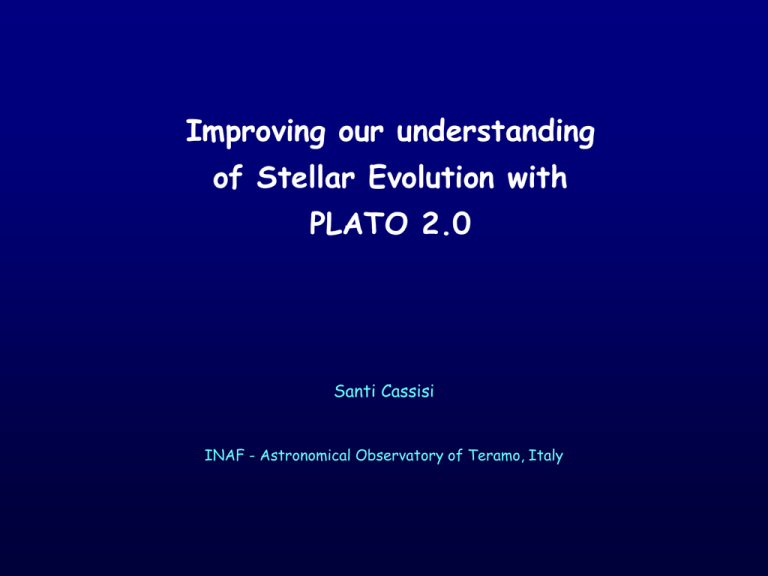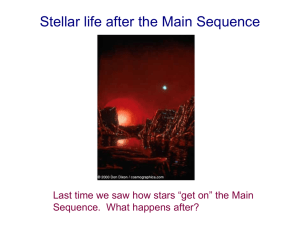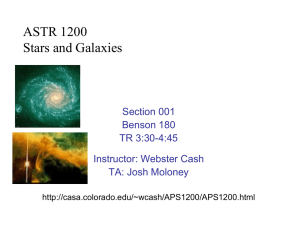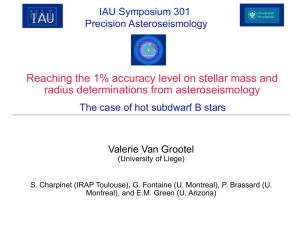ppt
advertisement

Improving our understanding of Stellar Evolution with PLATO 2.0 Santi Cassisi INAF - Astronomical Observatory of Teramo, Italy PLATO2.0 Stellar Evolution The main focus of the PLATO asteroseismology program will be to support exoplanet science by providing: stellar stellar stellar masses with an accuracy of better than 10%; radii to 1-2%; what is the current ages to 10% accuracy; accuracy uncertainty? The PLATO mission will provide the observational framework in order to: improve understanding of stellar structure/physics; identify “missing physics”; improve our knowledge on stellar evolution; Rauer’s talk & Rauer et al. (2014) Stellar Evolution: the “ingredients” An evolutionary code Physical inputs Mixing treatment • Numerics • Boundary conditions • 1D versus 3D • • • • • Equation of State Radiative opacity Conductive opacity Nuclear reaction rates Neutrino energy losses • • • • Overshooting Superadiabatic convection Semiconvection Breathing pulses Microscopic mechanism • Atomic diffusion • Radiative levitation Additional mechanism • • • • Mass loss Rotation Magnetic field Internal gravity waves what is the <effect> of the “ingredients’s uncertainty” on age dating of individual stars? An evolutionary code Physical inputs Mixing treatment • Numerics • Boundary conditions • 1D versus 3D ≈4% for LMS - ≈0% for IMS ≈3% • • • • • Equation of State Radiative opacity Conductive opacity Nuclear reaction rates Neutrino energy losses • • • • up to 10% for MS stars- ≈0% for He-burn Overshooting ≈0% Superadiabatic convection Semi-convection >3% Breathing pulses ≈10% Microscopic mechanism • Atomic diffusion • Radiative levitation Additional mechanism ≈0% • • • • Mass loss Rotation Magnetic field Internal gravity waves ≈2-3% for H-burn – 10% for He-burn ≈6% for LMS - but… ≈0% ≈0% The impact of updated reaction rate on the transition mass between the Lower & Upper Main Sequence 14N(p,)15O - 17O(p,)18F 1.2M – solar composition The LUNA reaction rate predicts a larger total mass for the stars showing a convective core during the central H-burning stage. The global effect on the age dating is of the order of 7%. Atomic diffusion Diffusion velocity in the solar interior upward motion downward motion Helioseismological constraints (Bahcall et al. 97) strongly support the efficiency of this process More sophisticated models… A theoretical evidence: radiative accelerations can be up to 40% of gravity below the solar convection zone… for metal-poor stars, their value should be larger… (Turcotte et al. 98) An observational … suggestion: Slow extra-mixing at the bottom of convective envelope would improve the agreement concerning: •the observed abundances of Be and Li in the Sun (Richard et al. 96); •predicted sound speed profile and that derived by helioseismological data (Brun et al. 99); •spectroscopical measurements in Globular Cluster Stars (Gratton et al. 2003); It is necessary to account for atomic diffusion + radiative levitation + extra-mixing! Who is responsible for this non-canonical mixing? Non-canonical “transport mechanisms” • rotational induced mixings; • internal gravity waves; Baumann et al. (2010) Talon (2005) Asteroseismology of stars showing mixing modes can provide this information! These processes to be included in stellar models require the calibration of free parameters that are poorly constrained by “standard” observations Since rotational mixings affect not only chemicals but also the angular momentum distribution… to retrieve information about internal rotation profiles is mandatory! Asteroseismic constraints from observations of RG Stars The measurement with Kepler of the core rotation rates for hundreds of red giants is allowing an unprecedented view in the internal rotation evolution of evolved stars. RGB stars core He-burning stars Mosser et al. (2013) - Deheuvels et al. (2014) the inferred rotation periods are 10 - 30 days for ≈ 0.2M He degenerate cores on the RGB and 30 - 100 days for core He-burning stars The state-of-the-art of theoretical modelling Cantiello et al. (2014) Some evidences: •the envelope slows down as expected due to expansion and AM conservation; •the core rotates about 10 – 103 times faster than the values inferred by asteroseismology; •the trend of the core rotational rate with the radius is reversed with respect the observed ones; the amount of torque between the core and envelope is underestimated by RGB stellar models A query for (additional) non canonical physical mechanisms? Internal gravity waves • • IGWs could be excited by the convective envelope during the RGB; the details of their excitations and propagations are very poorly understood…; Large scale magnetic field • • if a magnetic field is present at the boundary of He core at the end of the MS stage, it could provide some coupling between core and envelope; what is its origin? fossil origin? generated by a convective dynamo during the central H-burning stage?; Mass loss along the Red Giant Branch • • Mass loss can significantly reduce the total mass and contribute to remove angular momentum; a still poorly understood physical mechanisms…; Can we still rely on Reimers’ “law”? “modified Reimers formula” “Mullan formula” 1.4 dM æ L ö µç ÷ dt è gR ø dM æ g ö µç 3 ÷ dt è R2 ø “Goldberg formula” -0.9 “Judge & Stencel formula” dM µ g -1.6 dt Reimers’ law is rejected at the 3 level… but we can’t distinguish among the alternatives! dM µ R 3.2 dt RGB mass loss & Asteroseismology < ΔM>/M=0.09±0.03 (random) ± 0.04 (systematic) More data are mandatory! Miglio et al. (2012) PLATO 2.0 will lead to a major progress in this area!!! The rotational rate pattern of low-mass HB stars (Behr 00 + 03, Recio-Blanco et al. 02, 04) Globular Clusters Field Stars Some embarrassments: •they rotate… •some of them rotate fast… •it seems to exist a discontinuity… Hot HB (sdB/sdO) stars: the great prospect of Asteroseismology The B subdwarfs are hot and compact (Teff ∼ 22000 – 40000 K and log g ∼ 5.2−6.2) in the core Heburning stage; Two groups of sdB pulsators offer favorable conditions for asteroseismology: sdBVr (or V361 Hya, or EC 14026) stars oscillate with periods in the 100–600 s range, corresponding mostly to low-order, low-degree p-modes; sdBVs (or V1093 Her) stars pulsate more slowly with periods of ∼1–2 h, corresponding to mid-order g-modes; a few stars belong to both classes and are called hybrid pulsators, showing both p- and g-modes; these modes are driven by a κ-mechanism induced by the so-called Z-bump in the mean Rosseland opacity, due to radiative levitation (Charpinet et al. 1996); sdB/sdO stars: very peculiar properties Heber (2009) The problem about the origin of Extreme HB stars is how some kind of mass-loss mechanism in the progenitor manages to remove all but a tiny fraction of the H envelope at about the same time as the helium core has attained the mass (∼0.5 M⊙) required for the He flash; This requires enhanced mass loss… The link between diffusive processes, mass loss along the HB & rotation is an open issue; sdB/sdO stars: evolutionary channels Depending on the amount of the residual H-rich envelope mass, the star will still ignite He burning: or at the top of the cooling sequence (Early Hot Flashers) or along the WD cooling sequence (Late Hot Flashers) The He Flash Induced mixing The occurrence of the He Flash-Induced Mixing Cassisi et al. (2003) – Miller Bertolami et al. (2008) •The final H abundance in the envelope is 0.0004 …very low but…still non-negligible; •A large amount of matter processed by both Hand He-burning is dredged to the surface…; •The final total metallicity is equal to 0.036, while the surface is strongly Carbon- (XC0.029) and He-enhanced (Y 0.96) Spectroscopical analysis are mandatory! To obtain accurate estimates of the total mass and of the envelope size is pivotal PLATO 2.0 will increase the number of sdB stars that can be investigated in deep detail with the tools of asteroseismology PLATO2.0 …What else…? PLATO can actually push a step forward current generation of stellar models… …maybe… a “new” more critical and ‘aggressive’ approach is required…








